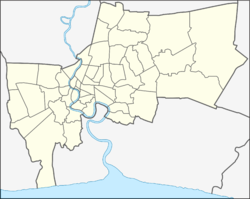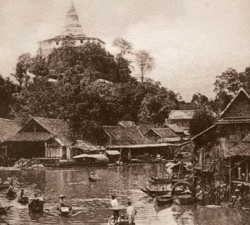Top Qs
Timeline
Chat
Perspective
Wat Saket
Buddhist temple in Bangkok, Thailand From Wikipedia, the free encyclopedia
Remove ads
Wat Saket Ratchawora Mahawihan (Thai: วัดสระเกศราชวรมหาวิหาร), usually shortened to Wat Saket, is a Buddhist temple (wat) in Pom Prap Sattru Phai district, Bangkok, Thailand.
The temple dates back to the Ayutthaya era, when it was known as Wat Sakae (วัดสะแก). When Bangkok became the capital, King Rama I (1737–1809) renovated the temple and gave it its present name (which roughly translates as "wash hair"); it was believed that on his return from the war, the king stopped to take a bath and wash his hair here, before entering the inner city.[2]
Remove ads
Phu Khao Thong
Summarize
Perspective

Phu Khao Thong (“Golden Mountain”, ภูเขาทอง) is a steep artificial hill inside the Wat Saket compound.
Rama I's grandson, King Rama III (1788–1851), decided to build a chedi of huge dimensions inside Wat Saket, but the chedi collapsed during construction because the soft soil of Bangkok could not support the weight. Over the next few decades, the abandoned mud-and-brick structure acquired the shape of a natural hill and was overgrown with weeds.[3] The locals called it the phu khao (ภูเขา, 'mountain'), as if it was a natural feature.[4] During that time, it also functioned as a lookout tower for soldiers concerned about the arrival of enemy armies.
During the reign of King Rama IV, construction began of a small chedi on the hill. It was completed early in the reign of his son, King Rama V (1853–1910) and sanctified by being covered in a layer of gold.[5] A relic of the Buddha was brought from Sri Lanka by Prince Pritsadang and placed in the chedi.[6] The surrounding concrete walls were added in the 1940s to stop the hill from eroding.[7] The modern Wat Saket was built in the early 20th century using Carrara marble.[8]
An annual festival is held at Wat Saket every November, featuring a candlelight procession up Phu Khao Thong to the chedi,[9] which is wrapped in a long red robe—just like the "Hae Pha Khuen That" (แห่ผ้าขึ้นธาตุ) festival at Wat Phra Mahathat in Nakhon Si Thammarat province, southern Thailand. Devotees write their names and their family member's names on the robe and pray, believing that their wishes will be fulfilled. This tradition has been observed since the reign of King Rama V.[10]
At the same time, a grand Loi Krathong festival takes place at the temple, accompanied by sideshows and freak exhibits such as Phi Krasue (ผีกระสือ; "a floating female ghost head with glowing entrails"), Dek Song Hua (เด็กสองหัว, "a two-headed child"), Mia Ngu (เมียงู, "the snake's wife"), or fun games like Sao Noi Tok Nam (สาวน้อยตกน้ำ, "the little girl falls into the water"), among others. The festival is well known among Bangkok residents.[11] The nearby Fort Mahakan community was once a hub of the fireworks industry, but following the demolition of the fort and relocation of the community, the trading of fireworks has been banned.[12][13][14]
Phu Khao Thong is now a popular Bangkok tourist attraction and has become a symbol of the city.

Remove ads
Vultures of Wat Saket
Summarize
Perspective
Cement crematorium near Wat Saket in the past (circa 1900); the black spots atop the crematorium are vultures waiting to eat the corpses. The crematorium was demolished to make way for the Men Pun intersection at the end of the Sommot Amon Mak bridge
In the early Rattanakosin period (between the reigns of Rama I and Rama V), the Siamese had a tradition of avoiding cremations within the city walls, believing them to be inauspicious. Wat Saket, located outside the fortified area, thus became a frequent site for funerals. Corpses were carried through the Pratu Phi, or 'ghost gate', to be cremated there.
In 1820, during the reign of King Rama II (1809–1824), a cholera outbreak spread from Penang to Bangkok, claiming over 30,000 lives in the capital. Wat Saket became the city's main receiving ground for the dead, alongside Wat Sangwet in Banglamphu and Wat Choeng Lane in Sampheng. The sheer number of bodies overwhelmed the cremation facilities. Many corpses were left exposed in the monastery's open areas, attracting flocks of vultures that came to feed. Wat Saket effectively became a feeding ground for carrion birds. Cholera outbreaks recurred each dry season until the early reign of King Rama V. The most severe epidemic occurred in 1840 during King Rama III's reign, when one in ten people in Siam and its surroundings perished. The final major outbreak came in 1881, with hundreds dying each day.
The image of vultures circling above Wat Saket became a haunting symbol of death. The phrase Raeng Wat Saket (แร้งวัดสระเกศ, "vultures of Wat Saket") entered popular speech, often paired with Pret Wat Suthat (เปรตวัดสุทัศน์, "preta of Wat Suthat")—a likely reference to ghostly legends surrounding the temple's murals.[15][2][3]
Remove ads
Gallery
- Wat Saket and Wat Ratchanatdaram, Bangkok
- Historic photo of Wat Saket and Golden Mount during King Rama V's reign
- The Golden Mount
See also
References
Sources
External links
Wikiwand - on
Seamless Wikipedia browsing. On steroids.
Remove ads







